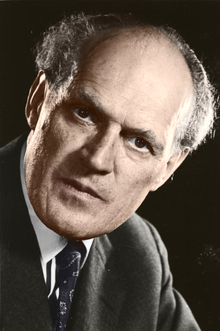
The Messerschmitt Me 262, nicknamed Schwalbe in fighter versions, or Sturmvogel in fighter-bomber versions, was the world's first operational jet-powered fighter aircraft. Design work started before World War II began, but problems with engines, metallurgy and top-level interference kept the aircraft from operational status with the Luftwaffe until mid-1944. The Me 262 was faster and more heavily armed than any Allied fighter, including the British jet-powered Gloster Meteor. One of the most advanced aviation designs in operational use during World War II, the Me 262's roles included light bomber, reconnaissance and experimental night fighter versions.

Messerschmitt AG was a German share-ownership limited, aircraft manufacturing corporation named after its chief designer Willy Messerschmitt from mid-July 1938 onwards, and known primarily for its World War II fighter aircraft, in particular the Bf 109 and Me 262. The company survived in the post-war era, undergoing a number of mergers and changing its name from Messerschmitt to Messerschmitt-Bölkow-Blohm before being bought by Deutsche Aerospace in 1989.

Wilhelm Emil "Willy" Messerschmitt was a German aircraft designer and manufacturer. In 1934, in collaboration with Walter Rethel, he designed the Messerschmitt Bf 109, which became the most important fighter aircraft in the Luftwaffe as Germany rearmed prior to World War II. It remains the second most-produced warplane in history, with some 34,000 built, behind the Soviet Ilyushin Il-2. Another Messerschmitt aircraft, first called "Bf 109R", purpose-built for record setting, but later redesignated Messerschmitt Me 209, broke the absolute world airspeed record and held the world speed record for propeller-driven aircraft until 1969. Messerschmitt's firm also produced the first jet-powered fighter to enter service — the Messerschmitt Me 262.

The Junkers Jumo 004 was the world's first production turbojet engine in operational use, and the first successful axial compressor turbojet engine. Some 8,000 units were manufactured by Junkers in Germany late in World War II, powering the Messerschmitt Me 262 fighter and the Arado Ar 234 reconnaissance/bomber, along with prototypes, including the Horten Ho 229. Variants and copies of the engine were produced in Eastern Europe and the USSR for several years following the end of WWII.

The Nakajima Kikka was Japan's first jet aircraft. It was developed late in World War II and the first prototype had only flown once before the end of the conflict. It was also called Kōkoku Nigō Heiki.

The Emergency Fighter Program was the program that resulted from a decision taken on July 3, 1944 by the Luftwaffe regarding the German aircraft manufacturing companies during the last year of the Third Reich.

The Sd.Kfz.2 is a half-track motorcycle with a single front wheel, better known as the Kleines Kettenkraftrad HK 101 or Kettenkrad for short.
Operation LUSTY was the United States Army Air Forces' effort to capture and evaluate German aeronautical technology during and after World War II.

Mittelwerk was a German World War II factory built underground in the Kohnstein to avoid Allied bombing. It used slave labor from the Mittelbau-Dora concentration camp to produce V-2 ballistic missiles, V-1 flying bombs, and other weapons.

Hinterbrühl is a town in the district of Mödling in the Austrian state of Lower Austria. It is home to the Seegrotte, a system of caves including Europe's largest underground lake. During World War II, a satellite camp of Mauthausen concentration camp was opened inside the caverns, producing parts for the He 162 Spatz jet fighter.

Wenzendorf is a municipality in Lower Saxony, Germany. It is also the name of the chief village of the municipality.

Mühldorf was a satellite system of the Dachau concentration camp located near Mühldorf in Bavaria, established in mid-1944 and run by the Schutzstaffel (SS). The camps were established to provide labor for an underground installation for the production of the Messerschmitt 262 (Me-262), a jet fighter designed to challenge Allied air superiority over Germany.
The Engelberg Tunnel is a motorway tunnel on the German A81 Autobahn (motorway) just to the west of Stuttgart on the outskirts of Leonberg. During World War II it was used as a Nazi forced labor factory for the manufacture and storage of aircraft parts.
Aircraft cavern, a calque of the German word Flugzeugkaverne, is an underground hangar amongst others used by the Swiss Air Force.
The German Air Ministry had a system for aircraft designation which was an attempt by the aviation authorities of the Third Reich to standardize and produce an identifier for each aircraft design's airframe type produced in Germany. It was in use from 1933 to 1945 though many pre-1933 aircraft were included and the system had changes over those years. As well as aircraft of the Luftwaffe, it covered civilian airliners and sport planes, due to the RLM handing all aviation-related matters in the Third Reich, both civilian and military in nature.

In 1944 the Third Reich began work on the construction of a partially underground bunker factory codenamed Weingut I in the forest known as the Mühldorfer Hart, slightly to the west of Mühldorf am Inn in Upper Bavaria. Plans for the bunker called for a massive reinforced concrete barrel vault composed of 12 arch sections under which Messerschmitt Me 262 jet engines would be manufactured in a nine-storey factory.

The Jägerstab was a Nazi German governmental task force whose aim was to increase production of fighter aircraft during World War II. Established in March 1944, it was composed of government and SS personnel, as well as representatives of the aircraft manufacturers. The task force played a key role in the Emergency Fighter Program, including the "people's fighter" Heinkel He 162.

Gusen was a subcamp of Mauthausen concentration camp operated by the SS between the villages of Sankt Georgen an der Gusen and Langestein in the Reichsgau Ostmark. Primarily populated by Polish prisoners, there were also large numbers of Spanish Republicans, Soviet citizens, and Italians. Initially, prisoners worked in nearby quarries, producing granite which was sold by the SS company DEST.

The Messerschmitt Me 262 was a German World War II fighter aircraft built by Messerschmitt in the later stages of the war, and under license by Avia post-war.














